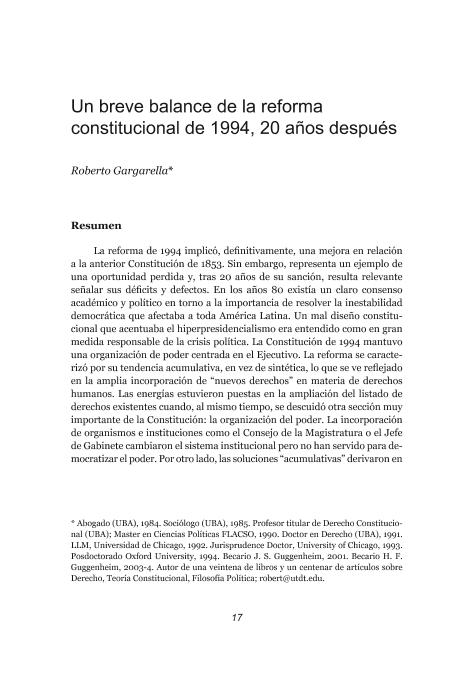Artículo
La reforma de 1994 implicó, definitivamente, una mejora en relación a la anterior Constitución de 1853. Sin embargo, representa un ejemplo de una oportunidad perdida y, tras 20 años de su sanción, resulta relevante señalar sus déficits y defectos. En los años 80 existía un claro consenso académico y político en torno a la importancia de resolver la inestabilidad democrática que afectaba a toda América Latina. Un mal diseño constitucional que acentuaba el hiperpresidencialismo era entendido como en gran medida responsable de la crisis política. La Constitución de 1994 mantuvo una organización de poder centrada en el Ejecutivo. La reforma se caracterizó por su tendencia acumulativa, en vez de sintética, lo que se ve reflejado en la amplia incorporación de “nuevos derechos” en materia de derechos humanos. Las energías estuvieron puestas en la ampliación del listado de derechos existentes cuando, al mismo tiempo, se descuidó otra sección muy importante de la Constitución: la organización del poder. La incorporación de organismos e instituciones como el Consejo de la Magistratura o el Jefe de Gabinete cambiaron el sistema institucional pero no han servido para democratizar el poder. Por otro lado, las soluciones “acumulativas” derivaron en problemas en su efectivización, en la medida en que ciertos nuevos derechos e instituciones entran en tensión con otros ya existentes. The constitutional reform of 1994 has definitely been an improvement in relation to the previous Constitution of 1853. However, it represents an example of a lost opportunity and, after 20 years of its passing, it is important to point out its deficits and flaws. In the 80’s there was a clear academic and political consensus on the importance of solving the democratic instability that affected Latin America. A bad constitutional design that emphasizes the hyper-presidentialism was seen, to a large extent, as the responsible of the political crisis. The Constitution of 1994 maintained an organization of power centered in the Executive. The reform was characterized by its accumulative tendency, instead of being synthetic, which is reflected in a great incorporation of “new rights” in matters of human rights. The energies were put in the increase of the list of rights when, at the same time, another important part of the Constitution was neglected: the one of the organization of power. The incorporation of organisms and institutions such as the Council of Magistracy or the Chief of Staff had changed the institutional system but were not useful for a democratization of power. Moreover, the “accumulative” solutions implied problems in its effectiveness, as certain new rights entered in tension with old ones.
Un breve balance de la reforma constitucional de 1994, 20 años después
Fecha de publicación:
09/2015
Editorial:
Universidad de Buenos Aires
Revista:
Pensar en Derecho
ISSN:
2314-0194
Idioma:
Español
Tipo de recurso:
Artículo publicado
Clasificación temática:
Resumen
Palabras clave:
Reforma constitucional
,
Derechos sociales
Archivos asociados
Licencia
Identificadores
Colecciones
Articulos(SEDE CENTRAL)
Articulos de SEDE CENTRAL
Articulos de SEDE CENTRAL
Citación
Gargarella, Roberto; Un breve balance de la reforma constitucional de 1994, 20 años después; Universidad de Buenos Aires; Pensar en Derecho; 5; 9-2015; 17-34
Compartir




